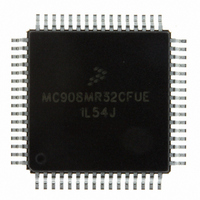MC908MR32CFUE Freescale Semiconductor, MC908MR32CFUE Datasheet - Page 223

MC908MR32CFUE
Manufacturer Part Number
MC908MR32CFUE
Description
IC MCU 8MHZ 32K FLASH 64-QFP
Manufacturer
Freescale Semiconductor
Series
HC08r
Datasheet
1.MC908MR16CFUE.pdf
(282 pages)
Specifications of MC908MR32CFUE
Core Processor
HC08
Core Size
8-Bit
Speed
8MHz
Connectivity
SCI, SPI
Peripherals
LVD, POR, PWM
Number Of I /o
44
Program Memory Size
32KB (32K x 8)
Program Memory Type
FLASH
Ram Size
768 x 8
Voltage - Supply (vcc/vdd)
4.5 V ~ 5.5 V
Data Converters
A/D 10x10b
Oscillator Type
Internal
Operating Temperature
-40°C ~ 85°C
Package / Case
64-QFP
Processor Series
HC08MR
Core
HC08
Data Bus Width
8 bit
Data Ram Size
768 B
Interface Type
SCI/SPI
Maximum Clock Frequency
8.2 MHz
Number Of Programmable I/os
44
Number Of Timers
6
Operating Supply Voltage
0 V to 5 V
Maximum Operating Temperature
+ 85 C
Mounting Style
SMD/SMT
Development Tools By Supplier
FSICEBASE, M68CBL05CE
Minimum Operating Temperature
- 40 C
On-chip Adc
10-ch x 10-bit
Lead Free Status / RoHS Status
Lead free / RoHS Compliant
Eeprom Size
-
Lead Free Status / Rohs Status
Lead free / RoHS Compliant
Available stocks
Company
Part Number
Manufacturer
Quantity
Price
Company:
Part Number:
MC908MR32CFUE
Manufacturer:
Freescale Semiconductor
Quantity:
10 000
Part Number:
MC908MR32CFUE
Manufacturer:
NXP/恩智浦
Quantity:
20 000
- Current page: 223 of 282
- Download datasheet (2Mb)
16.3.4.2 Buffered PWM Signal Generation
Channels 0 and 1 can be linked to form a buffered PWM channel whose output appears on the
PTE4/TCH0A pin. The TIMA channel registers of the linked pair alternately control the pulse width of the
output.
Setting the MS0B bit in TIMA channel 0 status and control register (TASC0) links channel 0 and
channel 1. The TIMA channel 0 registers initially control the pulse width on the PTE4/TCH0A pin. Writing
to the TIMA channel 1 registers enables the TIMA channel 1 registers to synchronously control the pulse
width at the beginning of the next PWM period. At each subsequent overflow, the TIMA channel registers
(0 or 1) that control the pulse width are the ones written to last. TASC0 controls and monitors the buffered
PWM function, and TIMA channel 1 status and control register (TASC1) is unused. While the MS0B bit is
set, the channel 1 pin, PTE5/TCH1A, is available as a general-purpose
I/O pin.
Channels 2 and 3 can be linked to form a buffered PWM channel whose output appears on the
PTE6/TCH2A pin. The TIMA channel registers of the linked pair alternately control the pulse width of the
output.
Setting the MS2B bit in TIMA channel 2 status and control register (TASC2) links channel 2 and
channel 3. The TIMA channel 2 registers initially control the pulse width on the PTE6/TCH2A pin. Writing
to the TIMA channel 3 registers enables the TIMA channel 3 registers to synchronously control the pulse
width at the beginning of the next PWM period. At each subsequent overflow, the TIMA channel registers
(2 or 3) that control the pulse width are written to last. TASC2 controls and monitors the buffered PWM
function, and TIMA channel 3 status and control register (TASC3) is unused. While the MS2B bit is set,
the channel 3 pin, PTE7/TCH3A, is available as a general-purpose
I/O pin.
16.3.4.3 PWM Initialization
To ensure correct operation when generating unbuffered or buffered PWM signals, use this initialization
procedure:
Freescale Semiconductor
1. In the TIMA status and control register (TASC):
2. In the TIMA counter modulo registers (TAMODH–TAMODL), write the value for the required PWM
3. In the TIMA channel x registers (TACHxH–TACHxL), write the value for the required pulse width.
period.
a. Stop the TIMA counter by setting the TIMA stop bit, TSTOP.
b. Reset the TIMA counter and prescaler by setting the TIMA reset bit, TRST.
duty cycle generation and removes the ability of the channel to self-correct
in the event of software error or noise. Toggling on output compare also can
cause incorrect PWM signal generation when changing the PWM pulse
width to a new, much larger value.
In buffered PWM signal generation, do not write new pulse width values to
the currently active channel registers. User software should track the
currently active channel to prevent writing a new value to the active
channel. Writing to the active channel registers is the same as generating
unbuffered PWM signals.
MC68HC908MR32 • MC68HC908MR16 Data Sheet, Rev. 6.1
NOTE
Functional Description
223
Related parts for MC908MR32CFUE
Image
Part Number
Description
Manufacturer
Datasheet
Request
R
Part Number:
Description:
Manufacturer:
Freescale Semiconductor, Inc
Datasheet:
Part Number:
Description:
Manufacturer:
Freescale Semiconductor, Inc
Datasheet:
Part Number:
Description:
Manufacturer:
Freescale Semiconductor, Inc
Datasheet:
Part Number:
Description:
Manufacturer:
Freescale Semiconductor, Inc
Datasheet:
Part Number:
Description:
Manufacturer:
Freescale Semiconductor, Inc
Datasheet:
Part Number:
Description:
Manufacturer:
Freescale Semiconductor, Inc
Datasheet:
Part Number:
Description:
Manufacturer:
Freescale Semiconductor, Inc
Datasheet:
Part Number:
Description:
Manufacturer:
Freescale Semiconductor, Inc
Datasheet:
Part Number:
Description:
Manufacturer:
Freescale Semiconductor, Inc
Datasheet:
Part Number:
Description:
Manufacturer:
Freescale Semiconductor, Inc
Datasheet:
Part Number:
Description:
Manufacturer:
Freescale Semiconductor, Inc
Datasheet:
Part Number:
Description:
Manufacturer:
Freescale Semiconductor, Inc
Datasheet:
Part Number:
Description:
Manufacturer:
Freescale Semiconductor, Inc
Datasheet:
Part Number:
Description:
Manufacturer:
Freescale Semiconductor, Inc
Datasheet:
Part Number:
Description:
Manufacturer:
Freescale Semiconductor, Inc
Datasheet:











